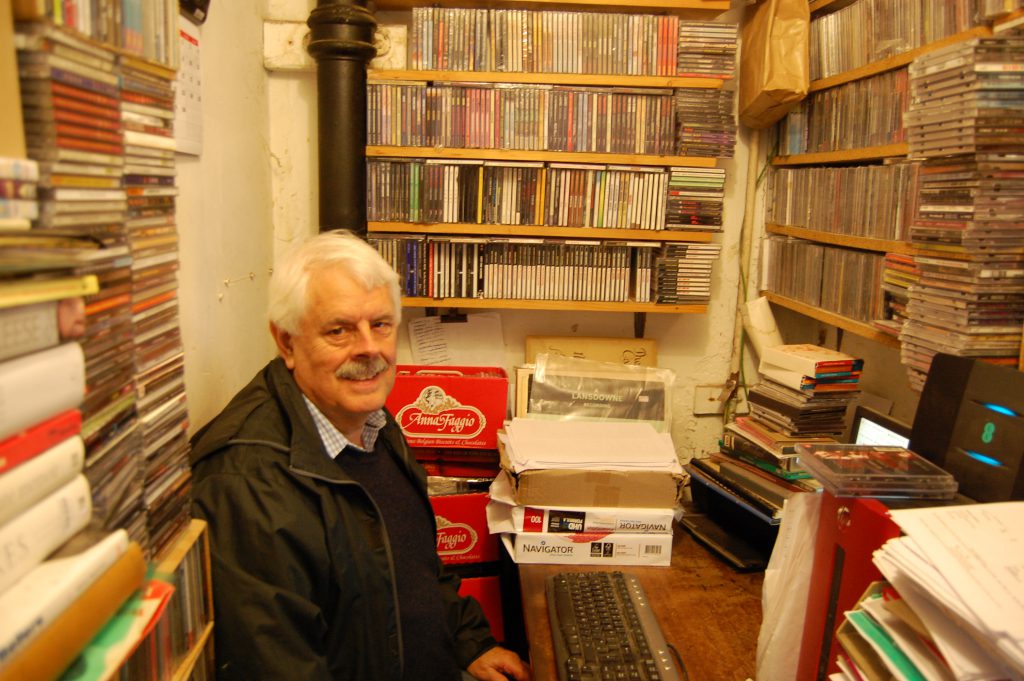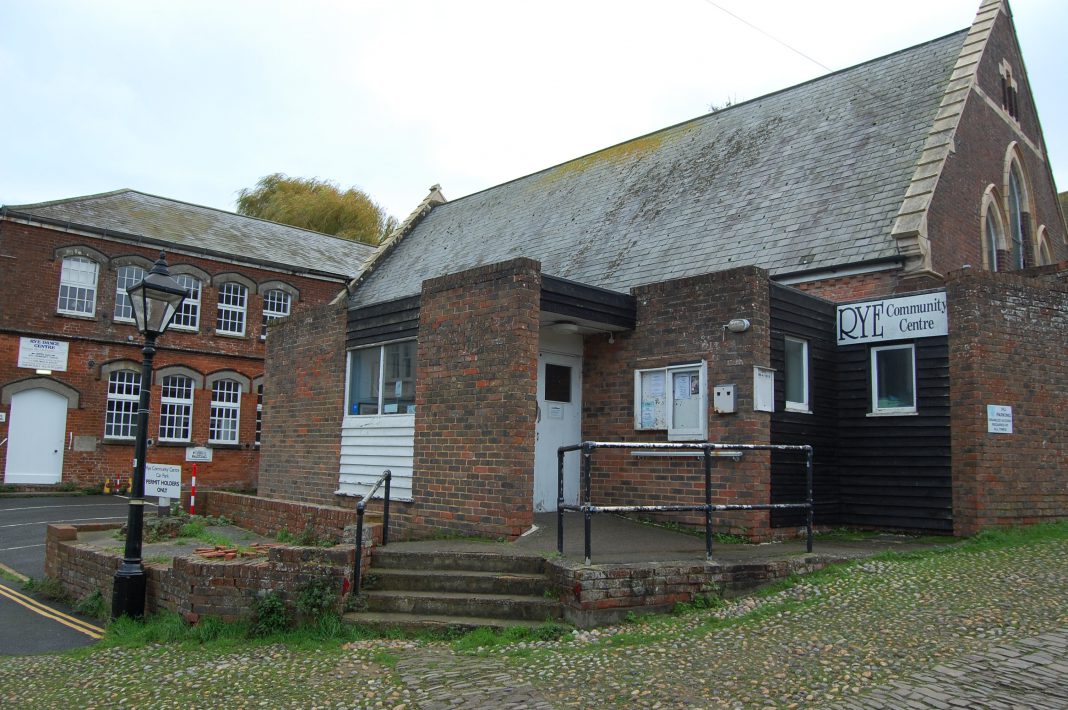Beginnings – the idea takes shape
The idea for starting a film club in Rye followed on from a successful film shown as part of the Rye festival in 1997. A small group of us met on March 4, 1998 around our dining-room table at 15 Market Street. There were David Willison, John Izod, Geoff Boudreau, Frank Jenks, Sheila Somerville, Margaret Bird and me. Of these, David, John, Geoff and me filled active roles with the club for many years; David Willison as chairman and cinematic technical expert; John Izod as artist, barman and genial factotum; Geoff as central kingpin at the community centre and film sourcing buff; and me as club treasurer and grant-getting specialist.
The obvious venue would be the community centre on Conduit Hill,owned and managed by the Rye Community Centre Association. As a registered charity, this would also provide an ideal umbrella organisation, with the club maintaining autonomous identity but enjoying all the available facilities, including a separate sub-banking account. In return, the club would donate its surplus income, if any, to assist the community association, a classic win-win arrangement.
The early years
The venture was launched in May 1998 with the film Brassed Off. The initial attendance was encouraging and film nights on the first Friday of each month quickly became a popular fixture in the calendar of Rye events. We started with two separate screenings but reduced this later to conserve the energies of our volunteers. By 2004, we had over 500 members, each paying £10 to cover up to three film attendances. More than a film club, it became a social gathering to which people looked forward to coming. The pre-film wine bar was an added attraction.
The club did not at first have enough money to buy a projector, so we hired one from a source in Eastbourne. Apart from the cost incurred, this of course involved two car journeys to collect and redeliver, a chore undertaken gallantly by David Willison with occasional help from other committee members. Fundraising to own our equipment became a priority, realised in fairly short order with a second-hand model.
It is true that the rest of the equipment left much to be desired; the screen was old and the wrong shape for many films and the sound system was rudimentary; the chairs were of the rigid plastic variety and not the most comfortable. All these concerns had to be addressed.
Purchase of equipment
At the club’s third AGM on December 1, 2000, the chairman was able to report that a second-hand projector had been purchased, a new screen installed, and the surround sound system improved. The community association had also provided new more comfortable chairs. The quest for higher performance standards continued through succeeding years. The club had been successful in sourcing grants for these and other projects; its treasurer holding the firm belief that if the project is his, persistence certainly paid off.
In 2004, Geoff Boudreau was offered the opportunity to buy 35 of the old velvet-covered tip-up seats originally installed in the Regent cinema in Cinque Ports Street. In a fit of nostalgia, the committee did agree to authorise a maximum purchase price of £250, but recorded reservations about how they would be stored given the multi-purpose uses of the main hall. Fortunately perhaps, the seller found another cinema buyer to take them on and instead 50 new cushions were purchased that year, a much better proposition.
By 2007, there was need for further upgrading. A new multimedia projector with Blu-ray projection facility was acquired that year and a new electric roll-up projector screen the following year. The sound system was improved and a hearing loop installed. All these installations were made possible through grant aid, sourced from a wide variety of charity funders; the Awards for All Lottery, the Rye Partnership, Sussex Community Foundation, Little Cheyne Wind Farm Fund, East Sussex Rural Development Agency, and Rother District Council under its market towns programme.
The films

Selecting the films that people wanted to see was no easy task. The committee would meet of an evening fortnightly in a local hostelry and Geoff Boudreau would produce a long list of recent film releases. With upwards of 12 performances a year, sourcing films was a mammoth task. There was often a short supply of suitable and current film releases that were likely to appeal in Rye with its demographic profile of above average elderly residents. Geoff in his small back office at Grammar School Records in the high street would spend literally hours chasing film suppliers like Filmbank and the British Film Institute.
There were certain films that were sure-fire winners that might be expected to attract an audience of 100 or more, mostly what were termed feel-good movies such as Monsoon Wedding, and Calendar Girls in 2004. Receipts from the showing of the Girl with a Pearl Earring reached £621, a record figure.
Our members were very loyal and generally trusted the committee’s choice. Not all the films found favour though; a membership survey in 2004 had one response on the film Best in Show: “this was the worst film we’ve attended, couldn’t endure more than half an hour!” The committee noted that “there’s no pleasing some folks”.
In May 2018, the club celebrated its 20th birthday with a re-showing of Brassed Off, a film that had been screened in its very first year.
New initiatives
In 2000, the millennium year, we started a Kids’ Club on Saturday mornings, organised by Eric and Krisha Watson. Initially heavily subsidised, they soon gained in popularity and ran for a couple of years until Eric Watson sadly had to retire.
Another initiative came the following year with the introduction of a world cinema series of foreign films. These were well supported and ran annually for several years in addition to the normal monthly programme. By 2007 however, audience numbers had declined and hiring costs were now exceeding revenue, so reluctantly the decision was made to discontinue them.
Reaching out into the community, the club started to host charity evenings in support of local voluntary organisations. Apart from regular support for the community association, amounting to several thousand pounds each year, special fund-raising events were held for local charities such as the Rye Memorial Care Centre, the swimming pool, the Rye festival and St John Ambulance. However, the hard lesson had to be learnt that these evenings were only successful if well-supported by the particular local organisation’s members.
Membership
Communicating with members was initially by hand-delivered newsletters four times a year. As numbers and postal charges increased however, cheaper methods became necessary. Fortunately, the growing use of email proved no deterrent to many filmgoers and the monthly issue of Fixtures produced by Adams Stationers was eagerly scanned. A notice board outside Grammar School Records shop also provided a timely reminder for passers-by.
As a result, membership grew rapidly, from 359 members recorded in 2000 to over 1,000 on the list twelve years later, although some of the original members had by then moved or passed on. On some evenings, numbers attending reached upwards of 140 filmgoers. Reluctance to turn people away led at times to the committee’s concern about health and safety compliance.
The refreshments counter in the lobby was well patronised, but when Annie Ullman joined the committee in 2005, she commented at one committee meeting on the quality of the wine. Geoff Boudreau agreed to source new supplies in the £3.50 to £4 price bracket in future; the guide price donation of £1 would be maintained however.
Admission to film was by presentation of a card bearing the member’s name. This entitled the individual member to attend up to three performances for the price of £10, later raised to £12 in 2008. The system was simple but it worked; on presentation at the cash desk, the card was punched with one hole for each of three performances, and then a new card would be issued against cash payment. There were no swipe card facilities in those days.
Competition
Notice of the film club’s success began to reach surrounding villages and around 2010 new film clubs began to spring up in Camber and Pett. There was also a growing market for home viewing on DVD though these tended to be of older films. The following year in June 2011, a committee meeting noted plans for developing the Kino behind the St Mary Centre in Lion Street and fears were expressed that this might jeopardise the club’s future. By December 2012, it was noted that audiences were averaging 55-60 members, a significant reduction from earlier peak viewing figures. However, there were still over 400 active members, and the club was still able to generate surplus income which helped to support the community centre.
When the Kino did eventually open its doors in January 2015, its impact was quickly felt with a significant downturn in attendances and membership. However, by opting for a change in film hiring arrangements, the club was able to keep going with much smaller audiences and a smaller break-even cost. The outbreak of the Covid pandemic put a stop to things with lock-down enforced closures until spring 2021 when they were able to resume and are continuing to this day.
The volunteers
This record would not be complete without naming many of those who actively gave their time and energies toward making the club the success. Over the near 25 years of the club’s existence, the band of volunteers has largely changed. We were fortunate from the first in having a band of dedicated projectionists: David Willison, Morris Metcalf, Phillip Romani, John Dawkins and Paul Carey. Other earlier helpers included David Aldridge, Mick and Dorothy Dodswell, Mary Smith, Harry Conlin and John Izod.
Of the longest serving, Geoff Boudreau stands out for his service for over 20 years; my tenure as treasurer was 16 years and John Holbrook projectionist and chairman has served more than 10 years. Other long-serving committee members were Neale East, Yvonne Metcalf, Janet Romani, Heidi Foster, and Annie Ullman. Valuable support came also from Margaret Holbrook, and Rita Kirk, later joined by Sarah Heenan, Jackie Brooks and Carol Cambaacsoes.
Recalling these names, some of whom are still actively engaged in the club, we can acknowledge the spirit of volunteering that has brought this service to the community for so many years. A further reflection is that most if not all these people were simultaneously active in other volunteering roles in many different local organisations. The voluntary sector is alive in Rye, but in great need of younger people, just retired and ready to look outwards from their work and families. The work may be challenging, even demanding at times, but the rewards of working with others in a voluntary effort have to be experienced to be understood.
Image Credits: Kenneth Bird .



